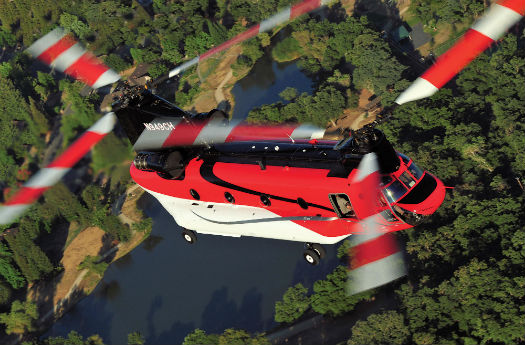
In its new life, the Boeing CH-47D will fight fires and do utility work.
Three Boeing CH-47D Chinooks have found a working life after the Army, after recently entering the utility and firefighting service with Helimax Aviation, Inc. of Sacramento, Calif.
In the last year, a number of ex-military CH-47Ds became available to civilian operators through U.S. government General Services Administration (GSA) auctions, and with the increasing use of heavy helicopters to combat wildfires, it was clear the aircraft would have a productive future. And, as a result of the CH-47’s 60-year history, there was no shortage of qualified and experienced support personnel with an in-depth operational understanding of the aircraft.
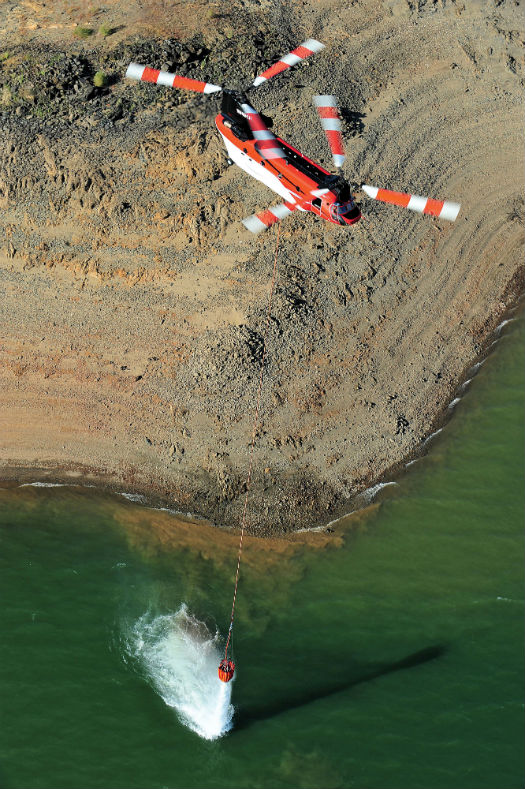
Using a 2,000 gallon Bambi Bucket with PowerFill Technology, the CH-47D is one of the most capable firefighting helicopters available.
“Helimax Aviation is excited to be a pioneer using the CH-47D in the commercial setting,” Christopher Turner, the company’s president, told Vertical. “I have a familiarity with this airframe, having operated B, C, and D model Chinooks during my time in the Army. We were also able to pull from our existing crews, who have considerable CH-47 experience when we staffed these aircraft. Because of this experience, we have a great understanding of the aircraft’s capabilities and are able to utilize it to the fullest. This airframe is incredibly versatile and reliable, and expands the solutions we are able to offer our customers worldwide.”
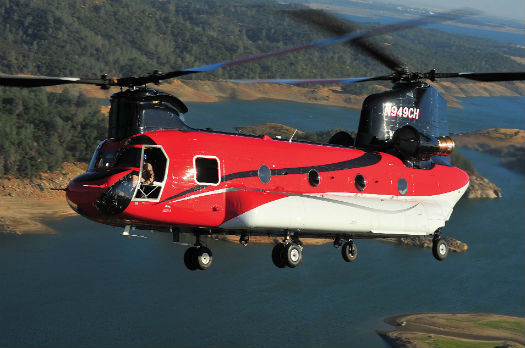
Flown both doors off, and in the future with a bubble window, the Chinook is a very versatile aircraft.
First introduced in 1979, the CH-47D shares the same airframe as earlier A, B, and C models. The main difference between the models was the introduction of progressively more powerful engines. The D model also saw an increased chord width in the main rotor blades, and the hydraulic system was simplified. The earliest CH-47Ds were equipped with Lycoming T55-L-712 engines, but these were later upgraded to the more powerful Lycoming T55-GA-714A, giving the helicopter better hot and high performance. With its extremely flexible triple-hook cargo system, which provided the ability to use each hook individually, the CH-47D could carry up to 26,000 pounds (11,790 kilograms) externally. Its spacious cabin also allowed for large internal loads, while in the cockpit, the variant introduced advanced avionics, such as the global positioning system. Nearly all U.S. Army CH-47Ds were conversions from previous A, B, and C models, with a total of 472 being converted. The last U.S. Army CH-47D built was delivered to the U.S. Army Reserve in 2002.
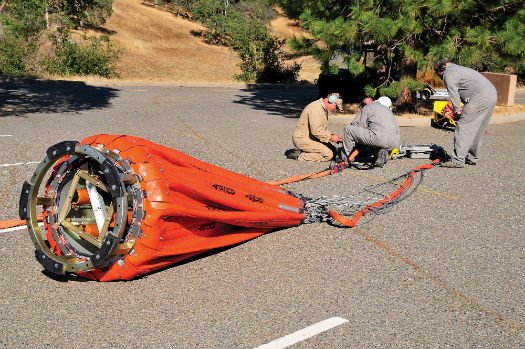
The Chinook fills up its Bambi Bucket.
Helimax, an affiliate of CHI Aviation of Howell, Mich., acquired the three CH-47Ds in the summer of 2014, becoming one of three civilian companies to operate the excess aircraft. The airframes were built or rebuilt in the late 1980s or early 1990s, and had recorded between 5,000 and 7,000 hours. Helimax acquired the aircraft to add additional capability to its fleet of Bell 205/212, Sikorsky S-61, and Airbus AS350 B3e aircraft, and to expand its operations further into the utility market. The Chinooks also open doors to future overseas contracts, including firefighting in Australia and possible U.S. Department of Defense contracts.
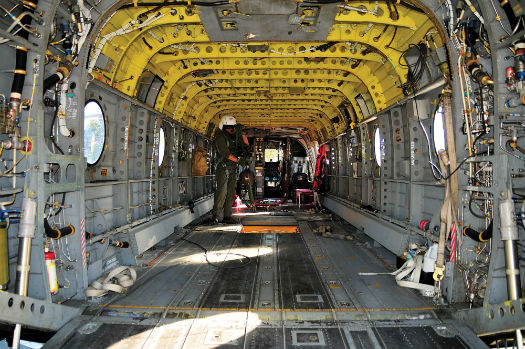
The Chinook cabin has enough volume to carry many types of loads.
The aircraft are rated to lift 26,000 pounds at sea level with an adjusted fuel load. For firefighting work, Helimax has outfitted each aircraft with a 2,000 gallon Bambi Bucket, with its PowerFill technology allowing the Chinooks to fill the bucket at lakes, rivers, or pools of water with extremely low water levels. “Bambi’s bottom-filling PowerFill capability gives us a much larger choice of water sources, and in many cases puts us closer to the fire where we can make an immediate difference,” lead CH-47D pilot Matt VanPelt told Vertical. “If we can find 18 inches of water depth, we should conceivably be able to get a load from any water source the bucket will fit in.” With the Bambi Bucket, lines, cables, and a full bucket of water, the weight lifted comes to 19,200 pounds (8,710 kilograms).
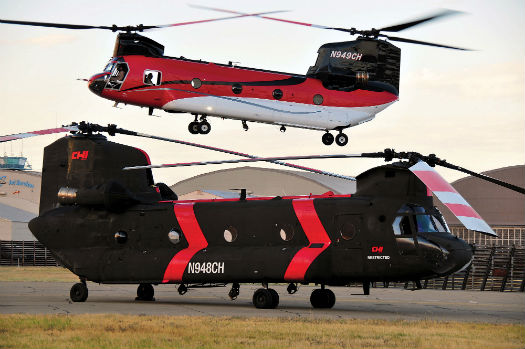
Two Helimax Chinooks pose for the camera.
“The delivered 2,000-gallon bucket drop with the ability to split and control the coverage level is a capability I have never had until now, but it is a capability I never want to give up in the future,” said VanPelt. “The split coverage drops just give us so much more flexibility to come around for another drop and nail the fire with one bucket load.”
VanPelt said crew resource management is important on such a large aircraft, so the required flight crew on a Helimax Chinook currently consists of a pilot-in-command, a co-pilot, and an additional crewmember in the rear cabin. That crewmember takes care of all rear cabin tasks including maintaining the hydraulic fluids, operating the ramp, watching bucket operations thru the “hell hole” in the bottom of the floor, and keeping an eye on the other aircraft systems. They also assist the pilots during all landings, both onsite and offsite. Up front, the pilot and co-pilot are tasked with dropping the Bambi Bucket loads during fires and all radio communications.
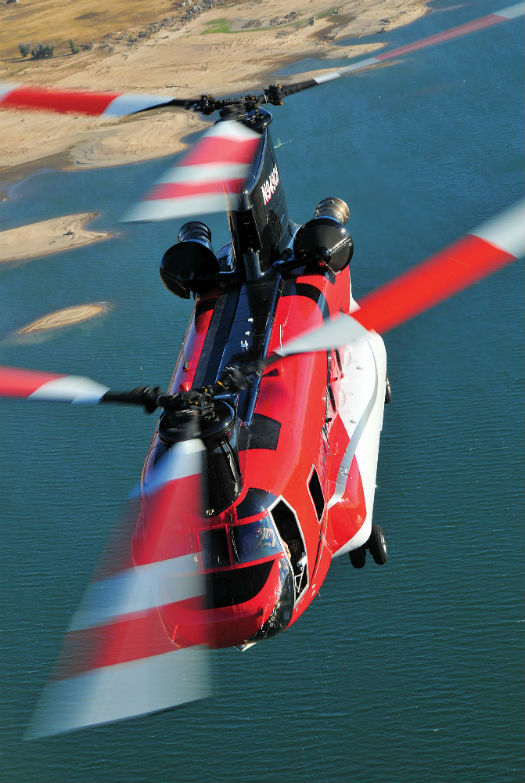
High visibility blades are required for fire-fighting service.
“I was originally a [Sikorsky] UH-60 Black Hawk pilot and thought it was an excellent airframe, but the CH-47D is the epitome of a workhorse helicopter,” said VanPelt. “I enjoy flying the Chinook, and it is now my favorite of all the aircraft I am qualified to fly, and that includes the Black Hawk. The stabilization systems and abundant power make for a comfortable steady, level flying platform with which to do aerial crane work, and a lift capacity of 13 tons is second to none.”
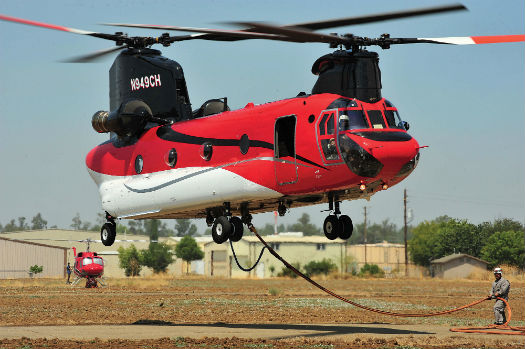
The CH-47D lifts during a fire.
During firefighting operations, Helimax deploys a Kawasaki Mule — an all-terrain vehicle— onboard the Chinook to immediately haul out and move the 1,200-pound (544-kilogram) Bambi Bucket and trailer. Crews had originally found it extremely difficult to move the Bucket efficiently because of its weight, but the mule allows it to be set up anywhere and deployed as soon as possible. Having the mule onsite once the aircraft arrives on a fire also gives the flight and support crews the ability to have transportation before the fuel and support vehicles arrive.

A CH-47D in-flight with the Bambi Bucket.
Although they’ve only been in operation with Helimax for a short time, the Chinook’s operational availability rates have exceeded the company’s expectations.
“These are robust, proven aircraft and [any issues] have been pretty much sorted out over [the D model’s] 30 years of service,” Josh Beckham, Helimax Aviation’s director of operations, told Vertical. “There aren’t many surprises and we have been able to find superb maintenance staff with decades of experience on these airframes. These guys understand the aircraft intimately, giving us the ability to keep them flying with the minimum of downtime. At this time, parts have not been a problem, and we expect to be able to operate the aircraft for many years to come.”
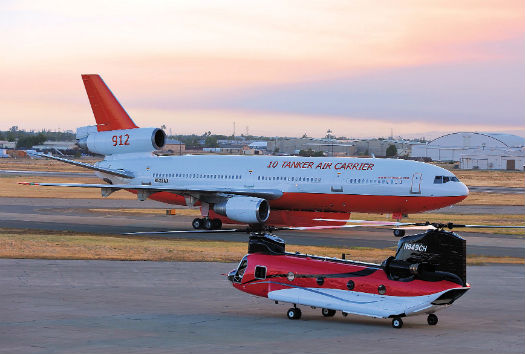
The ability to use multiple types of aircraft during a fire gives commanders flexibility during the fight. Here, a DC-10 tanker works together with a Helimax Chinook.
Safe in Helimax’s capable hands, these versatile machines will live on in the commercial world for the foreseeable future.





